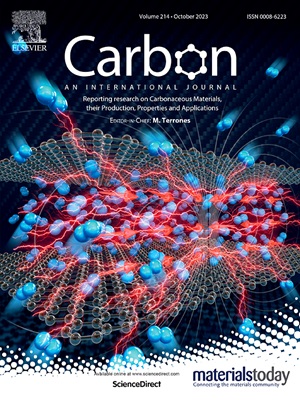水表面活性剂稳定石墨烯纳米片在液-气界面自组装的平铺特性
IF 10.5
2区 材料科学
Q1 CHEMISTRY, PHYSICAL
引用次数: 0
摘要
将原始的三维石墨直接液相剥离成超薄的石墨烯纳米片已经被认为是开发溶液处理技术以生产高质量样品的一种简单有效的方法。然而,由于传统涂层技术的限制,如喷涂、旋转涂层、滴铸、Langmuir-Blodgett沉积和印刷,将这种分散体转化为功能性和连续的石墨烯薄膜仍然具有挑战性。这些方法通常会导致纳米片的随机取向和聚集,从而导致更厚的薄膜,需要复杂的处理。尽管石墨烯由于其独特的结构而具有优异的物理性能,但其全部潜力尚未实现,这主要是由于缺乏高效和经济的薄膜制备方法。在这项工作中,我们报告了一种在液气界面上的自组装方法,该方法利用挥发性溶剂将分散的纳米片从液相中的随机运动引导成有序的平铺薄膜。在干燥过程中,毛细力在马兰戈尼效应的驱动下,随着挥发性溶剂的蒸发,在2分钟内在界面处迅速形成一个独特的单层。在~ 65 nm ~ ~ 1 μm范围内成功制备了具有不同长宽比、多层和可控膜厚的亚微米石墨烯薄膜。这些自组装石墨烯薄膜的电导率≥104 S/m,电阻温度系数为负8 × 10−4/°C。通过自组装方法形成致密堆积的石墨烯纳米片薄膜,为轻量化应用开辟了有希望的机会。本文章由计算机程序翻译,如有差异,请以英文原文为准。
Tiling characteristics of water-surfactant stabilized graphene nanosheets by self-assembly at liquid-air interface
Direct liquid phase exfoliation of pristine 3D graphite into ultra-thin graphene nanosheets has been recognized as a simple and effective method for developing solution-processed techniques to produce high-quality samples. However, transforming such dispersions into functional and continuous thin films of graphene remains challenging due to limitations of conventional coating techniques such as spray coating, spin coating, drop casting, Langmuir-Blodgett deposition and printing. These methods often result random orientation and aggregation of nanosheets leading to thicker films and requiring sophisticated processing. Although graphene possesses exceptional physical properties arising from its unique structure, its full potential has yet to be realized, largely due to the absence of efficient and cost-effective thin film preparation methods. In this work, we report a self-assembly approach at the liquid-air interface that utilizes a volatile solvent to guide the dispersed nanosheets from random motion in the liquid phase into an orderly, tiled thin-film. Capillary forces during the drying process, driven by the Marangoni effect, result in the rapid formation of a distinct monolayer at the interface within 2 min as the volatile solvent evaporates. Sub-micron graphene thin films with different aspect ratios, multilayers and controlled film thicknesses in the range of ∼65 nm to ∼1 μm are successfully prepared. These self-assembled graphene films demonstrate an electrical conductivity of ≥ 104 S/m and a negative temperature coefficient of resistance of −8 × 10−4/°C. The formation of densely packed graphene nanosheet films through the self-assembly approach opens promising opportunities for lightweight applications.
求助全文
通过发布文献求助,成功后即可免费获取论文全文。
去求助
来源期刊

Carbon
工程技术-材料科学:综合
CiteScore
20.80
自引率
7.30%
发文量
0
审稿时长
23 days
期刊介绍:
The journal Carbon is an international multidisciplinary forum for communicating scientific advances in the field of carbon materials. It reports new findings related to the formation, structure, properties, behaviors, and technological applications of carbons. Carbons are a broad class of ordered or disordered solid phases composed primarily of elemental carbon, including but not limited to carbon black, carbon fibers and filaments, carbon nanotubes, diamond and diamond-like carbon, fullerenes, glassy carbon, graphite, graphene, graphene-oxide, porous carbons, pyrolytic carbon, and other sp2 and non-sp2 hybridized carbon systems. Carbon is the companion title to the open access journal Carbon Trends. Relevant application areas for carbon materials include biology and medicine, catalysis, electronic, optoelectronic, spintronic, high-frequency, and photonic devices, energy storage and conversion systems, environmental applications and water treatment, smart materials and systems, and structural and thermal applications.
 求助内容:
求助内容: 应助结果提醒方式:
应助结果提醒方式:


